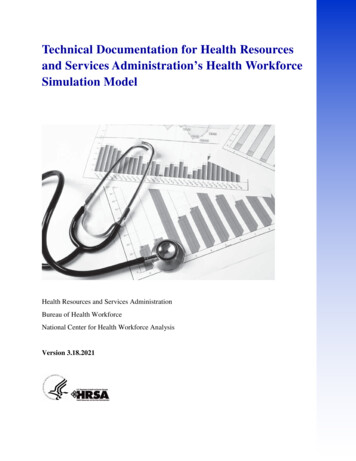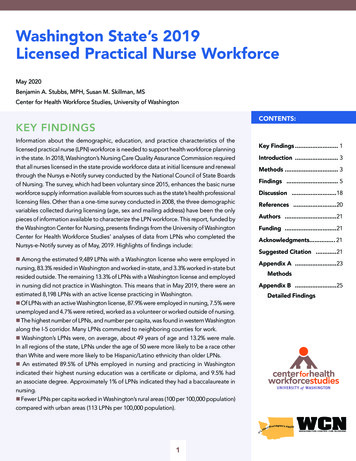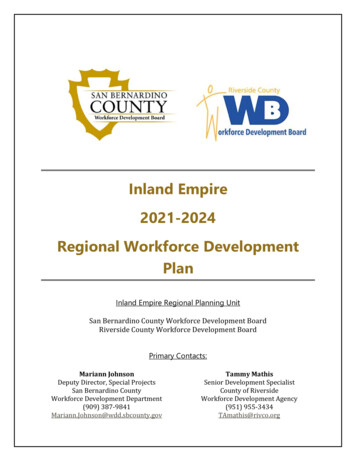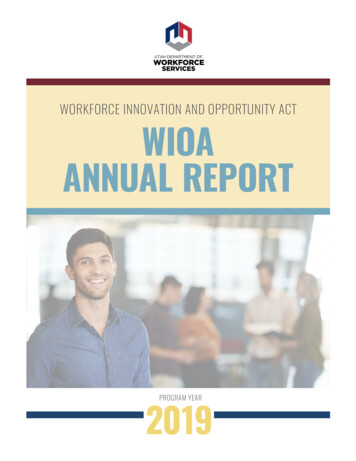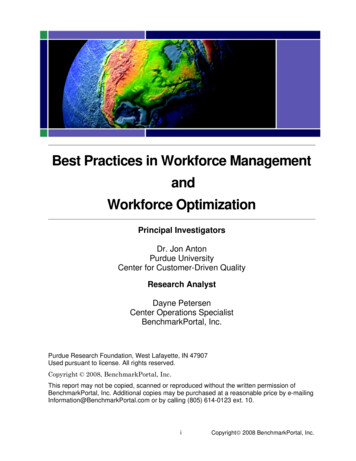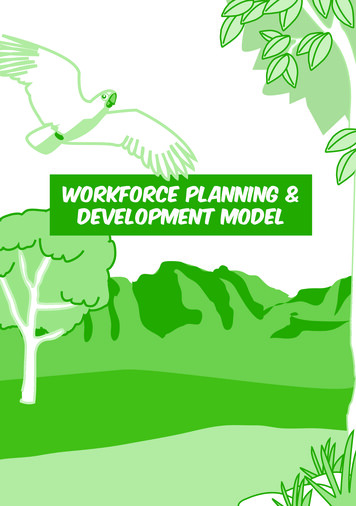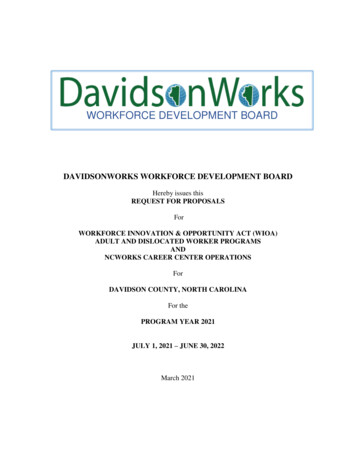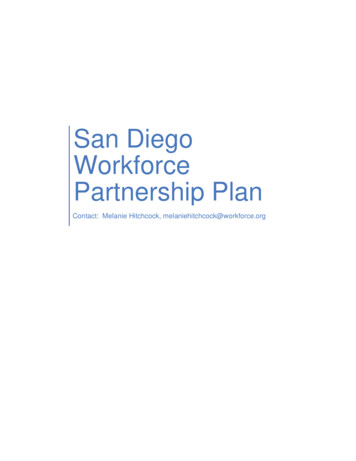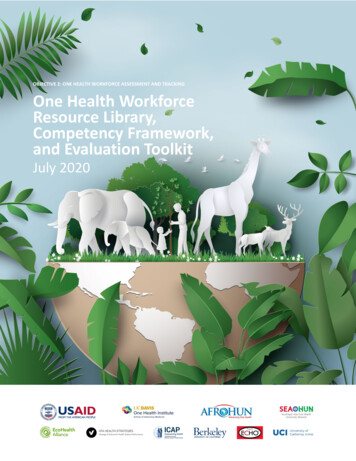
Transcription
OBJECTIVE 2: ONE HEALTH WORKFORCE ASSESSMENT AND TRACKINGOne Health WorkforceResource Library,Competency Framework,and Evaluation ToolkitJuly 2020
One Health Workforce Resource Library, Competency Framework, and Evaluation Toolkit (Mr. John John) July 2020OBJECTIVE 2: ONE HEALTH WORKFORCE ASSESSMENT AND TRACKINGOne Health Workforce Resource Library,Competency Framework, and EvaluationToolkitJuly 2020
One Health Workforce Resource Library, Competency Framework, and Evaluation Toolkit July 2020 3TABLE OF CONTENTSDEFINITIONS . 5INTRODUCTION . 6Need for OHW resource library, competency framework, and evaluation toolkit .6Objective of OHW resource library, competency framework, and evaluation toolkit .6Description of OHW resource library, competency framework, and evaluation toolkit .6Acknowledgement .7BACKGROUND . 8Competency-based training and evaluation .8METHODS . 9Backward Design approach to competency-based training and evaluation . 10Competency-based Workforce Assessment . 11Capability Maturity Model for Defining Proficiency at Four Levels . 13Kirkpatrick Model for Evaluating Training at Four Levels . 14Resource Mapping and Knowledge Management using Airtable . 15RESOURCE LIBRARY . 18Competency Resource Library . 19Competency Resources by Domain . 19Evaluation Resource Library . 20Evaluation Resources by Evaluation Level . 22COMPETENCY FRAMEWORK . 23Synthesized Competency Framework . 24Competencies by Domain . 24Competency Framework: Competencies by Proficiency Level in the OutbreakInvestigation and Response Domain . 27Level 1 Evaluation: Reaction . 30Level 1 Evaluation Tool: Learner Satisfaction Questionnaire . 30Level 2 Evaluation: Learning . 31Level 2 Evaluation Tool: Self-Assessment of Knowledge and Skill Checklist . 31Self-Assessment of Knowledge and Skills Checklist . 32Level 3 Evaluation: Behavior . 36Level 3 Evaluation Tool: Supervisor Direct Observation of Performance Checklist . 36Level 4 Evaluation: Results . 41Level 4 Evaluation Tool: Program Quality Checklist . 42
4 One Health Workforce Resource Library, Competency Framework, and Evaluation Toolkit July 2020ANNEX. 43OHW Competency Framework with Proficiency Level Across all Domains . 44OHW Evaluation Tool for Gender Domain Levels 1-4 . 72Level 1: Reaction . 72Level 2: Learning . 73Level 3: Behavior. 78Outbreak Investigation and Response - Level II Knowledge Assessment . 82Outbreak Investigation and Response and One Health Level Three Behavior Assessment . 86REFERENCES: . 92
One Health Workforce Resource Library, Competency Framework, and Evaluation Toolkit July 2020 5DEFINITIONSCompetencies are a blend of tacit and explicit knowledge, behaviour and skills that gives someone the potential foreffectiveness in task performance. 1 Competencies allow individuals to function in an organizational setting, or whenreferred to as work readiness competencies, impact the success of individuals and organizations, and that can beimproved by training and development. E.g. sets of competencies for analytical thinking, interpersonal skills,leadership, communication, system thinking and technical expertise in a particular area like One Healthcompetencies to attain the organizational goals efficiently and effectively.Competency proficiency assessment is a measurement that assigns an expected level of competence on a givencompetency. Leading practice scales have behavioral indicators as their building blocks with related behaviorsorganized under each competency. Scale ratings range from three to seven mastery levels, with five levels being themost common.Competency tier level: Each competency requires number of layers of knowledge to integrate with the identifiedwork assigned to the individual in the organization. Workplace competencies are needed in the knowledge economyto ensure their acquisition of skills as they progress through work tasks and job roles. Individuals progress throughthe levels of beginner, intermediate, advanced and expert as they gain further education, experience and applicationof specific job duties. Beginners are new entries to the field with minimal application of skill an experience whileexperts are leaders in the field with a wide variety of skills including organizational leadership and management. 2Competency management is the set of management practices that identify and optimize the skills andcompetencies required to deliver on an organization’s business strategy. Competency management provides thefoundation to develop strategic talent management practices such as workforce planning, acquiring top talent, anddeveloping employees to optimize their strengths.Competency-based framework (CBF) is a set of selected competencies of various domains for a specific discipline ororganization needed to achieve professional results. CBF provides a shared understanding and common language ofthe necessary knowledge, behavior and skills needed to achieve organizational objectives, and the framework will beused to design and develop evaluation strategies/tools. 3Domain: Competencies grouped in a large set by the type/area of knowledge or skill involved. E.g. One healthmanagement, outbreak investigation and response, system thinking. 4Module: A set of separate parts that, when combined, form a complete whole. In a single class, a module is achapter, class meeting or lecture on a specific topic. A domain may have different modules based on list of topics. 51 Sharma, P. (2017). Competence Development at the Workplace: a Conceptual framework. JK International Journal of Management and Social Science, 1(1).https://www.jkbschool.org/Chapter4.pdf2 National Institute of Health: Competencies Proficiency Scale. Available at: encies-proficiency-scale3 Benayouny, A. (2017). Competency-Based Framework: The Benefits and the Challenges. International Journal of Management and Applied Science, 3(9), 6-11.http://www.iraj.in/journal/journal file/journal pdf/14-407-15115027096-11.pdf4 Competency-to-Curriculum Toolkit, Columbia University: ency to Curriculum Toolkit08.pdf5 Definition of Module: ion-24493465c954da62
6 One Health Workforce Resource Library, Competency Framework, and Evaluation Toolkit July 2020INTRODUCTIONNEED FOR OHW RESOURCE LIBRARY, COMPETENCY FRAMEWORK, AND EVALUATIONTOOLKITCompetency frameworks are important to define what trainees need to know, understand, and be able to do.Training assessments are key to identify what trainees learn and determine if the training results in desired change.While there are a multitude of One Health Workforce trainings, some training manuals have not defined thecompetencies, and few to none according to level of proficiency. Many training manuals include an evaluationsurvey to measure learners’ reaction to the training, some have included assessments to measure learning outcomesof knowledge, but few have tools to measure learners’ behavior or results at the organizational or institutional level.There is a need to share lessons and synthesize resources across One Health Workforce training initiatives and toaddress gaps to enhance training quality and measure success.OBJECTIVE OF OHW RESOURCE LIBRARY, COMPETENCY FRAMEWORK, AND EVALUATIONTOOLKITThis manual was developed to promote competency-based training and evaluation for One Health Workforce byorganizing current approaches, methodologies, and tools into a resource library and building a competencyframework and assessment toolkit.DESCRIPTION OF OHW RESOURCE LIBRARY, COMPETENCY FRAMEWORK, AND EVALUATIONTOOLKITThis manual includes a resource library, competency framework, and assessment toolkit for One Health Workforcetraining programs. It builds on the abundance of expertise, experience, and resources developed by One HealthWorkforce training initiatives across 23 countries in Africa and Southeast Asia and around the globe. It includestheories, concepts, and methodologies for competency-based training and evaluation including the BackwardDesign, the Capability Maturity Model, and the Kirkpatrick four-level evaluation model.The resource library includes a mapping of existing competency frameworks, training materials, and evaluation toolsfrom One Health Workforce partners across 23 countries in Africa and Southeast Asia and external relevantmaterials. The resource library provides an organized global platform for searching, sharing, and accessing ofresources, tools, best practices, and materials for One Health Workforce training and assessment.The competency framework consists of competencies and sub-competencies organized across fifteen domains ofOne Health Workforce training and practice and defined at four levels of proficiency including beginner,intermediate, advanced, and expert. The competency framework provides guidance for defining what a One HealthWorkforce trained professional should know, understand, and be able to do.The evaluation toolkit consists of methods and tools for evaluating One Health Workforce training and practice atfour levels including reaction to training, learning outcomes, behavior and performance, and results at theorganizational and institutional level. The assessment toolkit provides guidance, methods, and tools for determiningthe effect and quality of One Health Workforce training.
One Health Workforce Resource Library, Competency Framework, and Evaluation Toolkit July 2020 7ACKNOWLEDGEMENTWe work to support competency-based training and evaluation to ensure high quality training that delivers results.We acknowledge the vast amount of work that has been done by One Health Workforce training initiatives globally,the value of a resource library for sharing lessons learned and materials across programs, and the utility ofcompetency-frameworks and assessment methods and tools to address gaps in trainings. This manual is not acomprehensive guide but an overview of selected approaches and practical tools that we hope you may find usefulto support your One Health Workforce training initiative.
8 One Health Workforce Resource Library, Competency Framework, and Evaluation Toolkit July 2020BACKGROUNDCOMPETENCY-BASED TRAINING AND EVALUATIONEffective competency-based frameworks create a real-time and predictive inventory of the capability of anyworkforce. By defining required job roles and associated competency proficiency, leadership can readily identifystrengths and skill gaps. Competency management then informs targeted skills development learning solutionsimproving individual and organizational performance, leading to better business results. These competencies areused to develop a competency framework that becomes an outline for learning development. The learningdevelopment may range from beginner through to expert/mastery for each of the competencies established in theframework structure.A competency framework defines the knowledge, skills, and attributes needed for people within a profession ororganization. Each role will have its own set of competencies required to perform a specific function effectively.Such a framework usually includes a number of competencies that are applied to multiple levels and occupationalroles. Each competency statement defines, in generic terms, excellence in working behavior; this definition thenestablishes the benchmark against which individuals are assessed. A competency framework is a means by whichinstitutions communicate in which behaviors or skills are required, valued, recognized and rewarded with respect tospecific professional or occupational roles. The competency-based framework has the following expected keybenefits: linking job requirement to organizational strategic goals,reduce the cost of training by identifying real training needs through identifying the competency gaps,providing a roadmap for employee development and career planning,providing a common understanding of the behaviors needed to achieve organizational objectives, andpromoting employees based on performance rather than solely on seniority.Competency framework includes domains, high-level competencies and sub-competencies, and functionalcompetencies. Functional competencies are defined by duties and responsibilities assumed by individuals for a giventask.
One Health Workforce Resource Library, Competency Framework, and Evaluation Toolkit July 2020 9METHODS
10 One Health Workforce Resource Library, Competency Framework, and Evaluation Toolkit July 2020METHODSFour key theories and methods underly our approach to development of the OHW competency framework andassessment toolkit. The Backward Design approach guides development of competency-based learning andassessment. Competency based workforce assessment in professional development programs clears the path formore detailed and accurate workforce planning, certification, skill acquisition, deployment of changing healthcareneeds, and many other purposes. The Capability Maturity Model informs the delineation of competencies accordingto level of proficiency from beginner, intermediate, advanced, to expert. And the Kirkpatrick evaluation modelinforms the assessment of training at four levels including learners’ reaction, learning outcomes, behavioralperformance, and results at the organizational level.BACKWARD DESIGN APPROACH TO COMPETENCY-BASED TRAINING AND EVALUATIONThe Backward Design (BD) approach is well-known for creating competency-based training, and is a compellingstrategy for achieving results-based, participant-centered education program. 6 The BD approach defines thecompetencies needed to achieve organization’s strategic goals, and, in the context of One Health, provides a vehiclefor integrating the health needs of a country with the priorities of the profession. The three step backward design, asindicated in Fig 1, begins by first defining the desired competency or performance, secondly determining assessmentand evaluation methods and measures, and third by developing the educational content. The competencies are thebuilding blocks for high-quality individual and organizational performance and development of assessmentstrategies and tools. Competency evaluation is the foundation of competency management of workforcedevelopment. 7 Thus, the BD approach will be used to develop a generic One Health education competency-basedframework followed by competency assessment toolkits. This document addresses steps 1 and 2.Figure 1: The three steps backward design for educational ormance6 Reynolds, H. L., & Kearns, K. D. (2017). A planning tool for incorporating backward design, active learning, and authentic assessment in the college classroom. CollegeTeaching, 65(1), 17-27.7 Scoresby, J., Tkatchov, M., Hugus, E., & Marshall, H. (2018). Applying service design in competency‐based curriculum development. The Journal of Competency‐BasedEducation, 3(3), e01171.
One Health Workforce Resource Library, Competency Framework, and Evaluation Toolkit July 2020 11The detailed steps of BD course planning are well depicted in Fig 2, which ICAP at Columbia University adapted fromthe Wiggins et al. (2005) model, from defining competencies to development of evaluation methods and contents. 8The first stage of the model is also broken down into the sequence of identifying/developing competencystatements, specifying sub-competencies for each competency statement (when needed) and then writing cognitive,behavioral and affective learning objectives for each competency or sub-competency statement. The second stageincludes the development of assessments which provide evidence of skill acquisition and competency development.In this competency framework, Kirkpatrick’s Four Levels of Evaluating Training Programs is specified for developingmeasures and evaluation methods. Evaluation is the crucial step of a competency-based training program becausethe competency assessments make up the participants’ level of knowledge and skills and are the sole determiner ofsuccess. The third stage identifies the instructional methods and materials that will be used to achieve the learningoutcomes. This includes various types of instructional delivery and activities such as hands-on procedures,demonstrations, lecture or guided practice. This manual addresses steps 1 and 2, determining learning outcomesand assessments.Figure 2: Backward educational planning and curriculum development approach. Adapted from Wiggins et al. (2001. What learners should know,understand and be able to doLearning OutcomesCompetenciesSub-competenciesLearning objectives2. Assessment measures of what learnersknow, understand, and are able to doContinuum of AssessmentsKirkpatrick’s 4 Levels1. Reaction2. Learning3. Behavior4 Results3. Activities and instruction toachieve learning outcomesInstructional Methods & MaterialsHands-on procedure, lab, live or videodemonstration, simulation, role-play,action plan, guided practice withfeedback, preceptingCOMPETENCY-BASED WORKFORCE ASSESSMENTCompetency management is the entire process of assigning, assessing, and tracking the knowledge, skills, andexperience required to perform specific activities. Institutions have an objective approach of ranking and evaluatingtrainees or employees against the training and learning that is being performed. Competency assessment inprofessional development programs clears the path for more detailed and accurate workforce planning,certification, skill acquisition, deployment of changing healthcare needs, and many other purposes (figure 3).8 Wiggins, G., Wiggins, G. P., & McTighe, J. (2005). Understanding by design. ASCD. Page 18.
12 One Health Workforce Resource Library, Competency Framework, and Evaluation Toolkit July 2020Figure 3: Significance of competency management and evaluationSKILL ANCEMANAGEMENTSUCCESSIONMANAGEMENTA competency-based workforce assessment supports growth at both the individual and organizational level.Organizations are able make better hiring decisions utilizing on competency-based screening tools, develop strategicemployee training plans and identify targeted areas for continued training and education within their workforce. Atthe individual level, competency-based workforce assessments support employees have clear expectations for theirroles, responsibilities, and deliverables, understand their areas of growth and focus their trainings to developedspecific skills. 9Utilizing a competency-based workforce assessment tool will allow organizations such as AFROHUN and SEAOHUNto identify gaps in education and training programs that support the OH workforce. These assessments can beutilized to identify the areas where additional education is required including revising curriculum at the universitylevel, short-term, targeted in-service training or continued professional development.9 National Institute of Health (2015). Workforce Planning Toolkit: Competencies Overview. Pgs. mpetenciesoverview.pdf
One Health Workforce Resource Library, Competency Framework, and Evaluation Toolkit July 2020 13CAPABILITY MATURITY MODEL FOR DEFINING PROFICIENCY AT FOUR LEVELSThe key OH competencies are categorized along a continuum from beginner to expert using capability maturitymodel, defining performance. Based on the complexity and level of responsibility, an average of three to fivefunctional competencies is assigned under each task in the drafted OH competency framework, as shown below inTable 1. The functional competencies are further categorized using the capacity maturation model (CMM) frombeginner to an expert level based on the level of education and experiences of skill acquisition.Table 1: Capability Maturity Model for OHWProficiencytier levelDescription of the competency staging levels 10111213Beginner/NoviceA beginner worker is one who can demonstrate an elementary level of performance and focusing on developingunderstanding through on-the-job experience. Beginners might have gained enough classroom or on-the-jobtraining to note recurring principles and themes but might not yet be able to apply them consistently. The beginnerworker might have sufficient subject matter knowledge but has limited experiential knowledge needed to performa task, behavior, or function without frequent guidance or oversight.IntermediateAn intermediate professional is one who has been in the same or similar job and who begins to see their actionswithin the context of the OH's long-range goals and plans and focusing on enhancing knowledge or skill. Theintermediate OH professional is developing knowledge and experience to recognize a situation in terms of anoverall picture or in terms of which aspects are most salient or most important. The intermediate worker has thenecessary ability to cope with OH approaches and is able to perform a task, behavior, or function with a high degreeof independence.AdvancedAdvanced OH professionals understand situations as a whole and perceive their meaning in terms of the OH longterm goals, and focusing on broader professional issues. The advanced person learns from experience or has takenintensive experiential training with practical application and knows how plans need to be modified in response tospecific events. The advanced OH professional uses established principles to manage complex processes and hasdeveloped sufficient mastery to integrate or design a new task, behavior, or function.ExpertThe expert OH professional, with substantial experience and knowledge, has an intuitive grasp of situations andfocuses on the root of the problem at a strategic level. The expert operates from a deep understanding of the totalsituation and integrates systems thinking, collaborative relationships, and the resources at their disposal to achievethe OH strategic goals. The expert has acquired mastery to design new strategies, policies, tasks, behaviors, andfunctions that support quality operations.The stages of competency or skill of the maturation model (Figure 4) was used for developing the OH competencyframework of the two domains which is designed and developed with the key functional competencies in Table 4.Following the development of the OH competency framework with the capability maturity model, the next step willbe identifying existing assessment methods and tools that map to each competency and develop these where theyare missing. These resources will be compiled into a toolkit, enabling educators and trainees to establish and10 Fisher, C., Cusack, G., Cox, K., Feigenbaum, K., & Wallen, G. R. (2016). Developing competency to sustain evidence-based practice. The Journal of nursing administration,46(11), 581.11 Benner, P. (1984). From novice to expert. Menlo Park.12 Dreyfus SE, Dreyfus HL. A five-stage model of the mental activities involved in directed skill acquisition. Berkeley, CA: University of California–Berkeley; 1980.13 National Institute of Health: Competencies Proficiency Scale. Available at: encies-proficiency-scale
14 One Health Workforce Resource Library, Competency Framework, and Evaluation Toolkit July 2020document OH skills effectively. The generic OH competency framework and evaluation tools will benefit universitynetworks and countries to use as a reference and adapt to the local settings, in consultation with national OHcoordinating bodies, policymakers, professional associations, and/or licensing agencies.Figure 4: Stages of competency or skill of maturation model used for developing the OH competency frameworkLimited Experience Developing On-the-jobexperience Understand terminology,concepts & principlesStart Practical Application Enhancingknowledge/skills Perform skill, need helpfrom expertApplied Theory Broad professional issues Perform skills withoutassistanceRecognized authority Strategic Consistent ateNoviceLevel-1Level-2Level-3Level-4KIRKPATRICK MODEL FOR EVALUATING TRAINING AT FOUR LEVELSThe Kirkpatrick Model 1415 is well-recognized to design evaluation strategies for classroom training, e-learning,informal learning, social learning, or any other type of modality in which individuals gain knowledge or skills to dotheir jobs more effectively. This model will be used for developing/updating OH assessment strategies and tools (Fig5). The Model consists of four hierarchical levels of evaluation. The most basic level, Level 1 (i.e., Reaction), assessesthe degree to which training participants find the training program favorable, engaging, and relevant to their jobs.The next level, Level 2 (i.e. Learning) measures the extent to which participants acquire the intended knowledge,skills, attitude, confidence and commitment based on their participation in the training. Level 3 (i.e. Behavior)evaluates the degree to which participants can apply what they learned during the training when they are back attheir jobs, so long as they are provided with the support they need. The highest level of evaluation, Level 4 (i.e.Results) assesses the degree to which targeted outcomes at organizations occur as a result of the training.16 IGWG, USAID, 2017, Participant Evaluation Form, aluationForm.pdf16 IGWG, USAID, 2017, Participant Evaluation Form, aluationForm.pdf
One Health Workforce Resource Library, Competency Framework, and Evaluation Toolkit July 2020 15Figure 5: Kirkpatrick’s Four Levels of Training BehaviorLevel-4:Results Measure participants’ reaction tounderstand training program &valuable insights into materialquality, facilitator, and more. E.g. Post-training survey,interviews, oral feedback & others. Measure how much information waseffectively absorbed from training, andgauge the level of participants in developingknowledge, or mindset. E.g. Pre/post-test, paper, peer evaluation(group exercise), trainer observation. Measure how much training influenced participantsbehavior, and evaluate how they apply theirknowledge. Assessing changes in behavior. E.g. Simulations (observation), Vignettes, supervisorymonitoring, interview after self-assessment or exam,360-degree feedback. Measure and analyze the impact of training atorganizational/business level, and be sure to tie it to theindividual or the program. E.g. Field-based project, research project, use control group.RESOURCE MAPPING AND KNOWLEDGE MANAGEMENT USING AIRTABLEMapping and synthesis was conducted to identify existing resources and tools for OHW training and practice across23 countries in Southeast Asia and Africa and external relevant mater
Effective competency-based frameworks create a real-time and predictive inventory of the capability of any workforce. By defining required job roles and associated competency proficiency, leadership can readily identify strengths and skill gaps. Competency management then informs targeted skills development learning solutions


